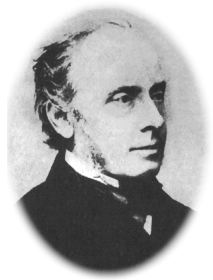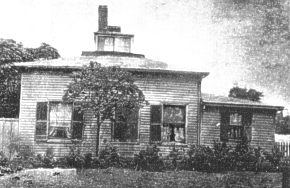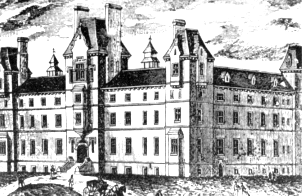

|
U.S. Beaumont genealogy |
U.S. Dr. William Beaumont's |
U.S. Dr. William Beaumont's birthplace |
U.S. Admiral Melancton Smith |
Canada's Dr. William R. Beaumont |
Coincidentally enough, there are two "Dr. William Beaumonts" who are both significant in medical history. Our family is related to the American Dr. William Beaumont (1785-1853), who researched the human digestive system; however, in the interest of sharing information with fellow Internet users, we are including this page on the Canadian Dr. William Rawlins Beaumont (1803-1875), surgeon and inventor. At present, we do not know if the two Dr. Beaumonts are related.
The Canadian Dr. Beaumont was born on Beaumont Street in Marylebone in London's west end, England, in September 1803 to Edward and Charlotte Beaumont, whose ancestors probably emigrated from France to England at the start of the 14th century. William was baptized in the Anglican Church of St. Marylebone in the parish of St. Mary's. William remained close to his elder brother Edward Beaumont (born 1801) even after William moved away to Canada; their sister Ann died in infancy (about 1797).

from a painting in the Academy of Medicine, Toronto |
As common with English medical students then, after completing formal medical school, Beaumont made a medical tour of Europe. He spent ten months in Paris, where he met surgeon Jean Zulema Amussat (1796-1856), a "renowned lecturer" and "mechanical genius, and in the shops of the instrument makers many surgical instruments were made by him" (footnote 3). Amussat taught Beaumont anatomy and mechanical and craft skills. Amussat himself was highly innovative; in 1835, he developed a successful technique for implanting an artificial anus. This feat is even more impressive when you realize that operations were still very painful; ether was first used for minor operations in 1842, and chloroform was first used in surgery in 1847.
After Paris, Beaumont briefly studied surgery at the University of Brussels before returning to England. On December 23, 1826, William Rawlins Beaumont passed his examinations and became a Member of the Royal College of Surgeons; he became a Fellow in 1836. He practiced medicine in London, as surgeon at the Farringdon Dispensary near St. Bartholomew's, and also at Islington Infirmary on London's north side.
Even as a new physician, Beaumont was innovative; in 1831, he experimented on setting broken bones in rabbits. He reported his results in a 31-page pamphlet, "The Treatment of Fractures of the Leg and Forearm by Plaster of Paris" (1831), comparing different methods of immobilizing fractures (including a compound fracture) in rabbits. He was criticized for suggesting that these procedures should be used on humans.
Beaumont emigrated to Toronto, Canada in 1841, where he became known to his friends as "Beaumont of Canada." At the time, Toronto's population of about 15,000 was served by about 20 physicians. Beaumont obtained by Canadian physician's license on November 12, 1842. Two weeks later, Beaumont and his wife Mary Catherine had a daughter, Charlotte Beaumont (born November 26, 1842).

(Godfrey, 112) |
In 1845, Beaumont was appointed to the examiners' commission at the Upper Canada Medical Board, which licensed physicians, surgeons, and midwives. The commission had 11 members, but applicants could be questioned by a minimum quorum of only three. Their standards were high — at Beaumont's first quarterly meeting in July 1845, five out of six applicants failed; at his second meeting in October 1845, all five applicants failed. Part of the physicians' examination tested the applicants' ability to read medical references in Latin (an old British university tradition); the exam also covered subjects such as anatomy, physiology, surgery, pharmacy, and chemistry.

(George W. Spragge, from an old print) |
Also in 1863, Beaumont became consulting surgeon to the Toronto General Hospital, the city's largest hospital. Two years later, he became blind in his left eye; he began deferring operations to other doctors, although he continued to assist.
In June 1866, William Rawlins Beaumont volunteered his medical services to the Canadian Army during the Fenian Raids (footnote 4); for about two weeks, he and another doctor were in charge of military hospital at Port Colborne, Ontario. Beaumont returned home to Toronto in mid-June; shortly after, his wife died of consumption.
A few of William Rawlins Beaumont's more interesting cases:
"He began by cutting a semicircular flap of skin away from both sides of the mouth and dissecting away the scar tissue between them. The two flaps of skin were then rotated until they met. Beaumont then fastened them together 'by two or three hare-lip pins. Union by adhesion took place between all the cut surfaces which were held together,' he wrote." (footnote 5)
In less than a month, Mary Ann had a new lip.
"(Beaumont) enlarged the hold with a slit on each side, but he went a step further by connecting 'the mucous membrane of the mouth (along the incision) with the skin of the cheek, by means of two points of interrupted suture.'"Four days later the sutures were removed. . .the artificial mouth was working." (footnote 6)
Beaumont later performed a second surgery to make the mouth appear more attractive. It is interesting to note that Beaumont took such excellent care with her, as Hannah was then a patient at the Provincial Lunatic Asylum; in those days, asylum "inmates" were often kept in chains.
Beaumont saw Watkins about 15 minutes after the accident. Beaumont tried to pull the stick straight out with forceps and then pliers, to no avail. He then used the pliers to hold the rocket-shaft, and then rotated the wood left-and-right until it was loose, when he was finally able to slowly pull it out. At that point, Watkins' wound began bleeding heavily, so Beaumont used ice water to stop the bleeding. Watkins insisted on going home and consulting his own doctor for further treatment.
Within three days, Watkins was able to walk; a month later, Beaumont met Watkins, who was now totally physically recovered although blind in the left eye. However, three years later, Beaumont again saw Watkins and now noted that Watkins' memory was quite impaired, although Watkins was still in good physical health. Beaumont presented the rocket-shaft to the museum of the Royal College of Surgeons of England.
Among other creations, William Rawlins Beaumont is credited with the following:
In his book, William R. Beaumont: mechanical genius, author Julian Smith thoroughly discusses this question in Chapter 12, "Did Beaumont Invent the Sewing Machine?" His conclusion:
Although Beaumont was a magnificent inventor of surgical instruments, he cannot be credited with the original concept of the sewing machine. Isaac Singer's sewing machine owed nothing to the surgical instruments of William Beaumont — neither the whole idea, nor any of its parts. . . . the principles (Singer) supposedly borrowed from Beaumont were already long known by the time Beaumont embarked on his inventive career. The eye-pointed needle dated back to the previous century [1755] while the principle of passing and arresting the thread had also received practical application long before Singer's time. It was the integration of all the parts that made a working sewing machine possible, which had already been accomplished by inventors like the Chapmans [Edward and William Chapman], [Balthasar] Krems, [Barthelemy] Thimonnier, [Walter] Hunt and [Elias] Howe. In fact, each of them (except Howe) developed their machines several years before Beaumont perfected his deep-suturing instrument. If there was any traffic in ideas, it is likely to have been in the opposite direction — from the sewing machine to Beaumont. It is even more probable that Beaumont derived some elements of his 1836 vaginal fistula instrument and his 1837 deep suturing instrument from sewing machines made years before." (footnote 8)
However, as Smith points out, Beaumont is still significant in medical history for: his surgical techniques and instruments; his teaching of a generation of Ontario doctors; his leadership within the Ontario medical profession; his pioneer work with chloroform, eye surgery, lithotomy, and facial reconstruction; and his commitment to his patients.
Sadly enough, this skilled surgeon lost sight in his left eye in 1865, ten years before his death; his right eye was also affected. For the next eight years, Beaumont was able to continue work as a surgeon, but he lost sight in his right eye in 1873 and was forced to retire. He died on October 13, 1875 at his daughter's home in Glenhurst, Toronto, Canada.
William Rawlins Beaumont (1803-1875) and his wife Mary Catherine (1822-1866) had two children:
SPOUSE: on October 17, 1863, in St. James' Anglican Cathedral in Toronto, Ontario, Canada, Charlotte Beaumont married Edgar John Jarvis, who was born in 1835; Edgar died January 15, 1907. Edgar Jarvis's parents were Frederick Starr Jarvis and Susan Isabella Merigold.
NOTE FOR SPOUSE: Edgar was a real estate businessman in Toronto. In 1866, Edgar and Charlotte moved to "Glenhurst, Yorkville," a house they built in an undeveloped suburb that is now the Rosedale residential area of Toronto. Charlotte and Edgar developed the Rosedale area; they later built "Sylvan Tower," Deancroft," and "Craigleigh."
CHILDREN: Charlotte Beaumont and Edgar John Jarvis had four children:
At this time, we have no further information on Beaumont's family.
FOOTNOTES
[1]Julian A. Smith, William R. Beaumont: mechanical genius, Canadian Medical Lives series, co-published in Markham, Ontario by Fitzhenry and Whiteside, c.1995 by Associated Medical Services Inc./The Hannah Institute for the History of Medicine; page 21Web-site design by Jamesette.com
This page last revised August 2020.
Sitemap